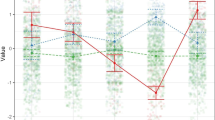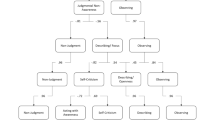Abstract
How well is trait mindfulness perceived by outside observers? This question has implications for the conceptualization of trait mindfulness and development and validity of self-report questionnaires. We examine this question via self-other agreement (SOA), observability, and evaluativeness of mindfulness. Study 1 investigated SOA of trait mindfulness with the Five-Facet Mindfulness Questionnaire (FFMQ) in a sample of undergraduates and close others. Self- and other-reports of FFMQ facets agreed more than they disagreed, with SOA correlations ranging from 0.19 to 0.25. Because outside observers are only privy to behaviors rather than internal cognitive and emotional states, SOA correlations suggest that the internal process of mindfulness likely manifests in observable behaviors. Study 2 investigated the observability and evaluativeness of mindfulness via the FFMQ in an independent sample. There were no strong relationships between SOA and either observability or evaluativeness of mindfulness. The absence of a negative relationship between evaluativeness and SOA suggests that SOA is not strongly impacted by enhancing biases in self-report. The absence of a positive relationship between observability and SOA suggests that the observability of the process of mindfulness does not strongly influence the perception of mindfulness by an outside observer. Taken together, results from these two studies suggest that others do perceive mindfulness, and yet the information upon which they base their judgments remains unclear. In keeping with Buddhist teachings and intervention science, we suggest that if process-related behaviors are not used to judge mindfulness, perhaps outcome-related behaviors are used instead.


Similar content being viewed by others
References
Asendorpf, J. B., & Ostendorf, F. (1998). Is self-enhancement healthy? Conceptual, psychometric, and empirical analysis. Journal of Personality and Social Psychology, 74(4), 955–966. doi:10.1037//0022-3514.74.4.955.
Baer, R. A. (2003). Mindfulness training as a clinical intervention: a conceptual and empirical review. Clinical Psychology: Science and Practice, 10(2), 125–143. doi:10.1093/clipsy/bpg015.
Baer, R. A., Smith, G. T., Hopkins, J., Krietemeyer, J., & Toney, L. (2006). Using self-report assessment methods to explore facets of mindfulness. Assessment, 13(1), 27–45. doi:10.1177/1073191105283504.
Baer, R. A., Smith, G. T., Lykins, E., Button, D., Krietemeyer, J., Sauer, S., et al. (2008). Construct validity of the five facet mindfulness questionnaire in meditating and nonmeditating samples. Assessment, 15(3), 329–342. doi:10.1177/1073191107313003.
Barnes, S., Brown, K. W., Krusemark, E., Campbell, W. K., & Rogge, R. D. (2007). The role of mindfulness in romantic relationship satisfaction and responses to relationship stress. Journal of Marital and Family Therapy, 33(4), 482–500. doi:10.1111/j.1752-0606.2007.00033.x.
Benn, R., Akiva, T., Arel, S., & Roeser, R. W. (2012). Mindfulness training effects for parents and educators of children with special needs. Developmental Psychology, 48(5), 1476–1487. doi:10.1037/a0027537.
Bishop, S. R. (2004). Mindfulness: a proposed operational definition. Clinical Psychology: Science and Practice, 11(3), 230–241. doi:10.1093/clipsy/bph077.
Brown, K. W., & Ryan, R. M. (2003). The benefits of being present: mindfulness and its role in psychological well-being. Journal of Personality and Social Psychology, 84(4), 822–848. doi:10.1037/0022-3514.84.4.822.
Colvin, C. R., Block, J., & Funder, D. C. (1995). Overly positive self-evaluations and personality: negative implications for mental health. Journal of Personality and Social Psychology, 68(6), 1152–1162. doi:10.1037//0022-3514.68.6.1152.
Condon, P., Desbordes, G., Miller, W. B., & DeSteno, D. (2013). Meditation increases compassionate responses to suffering. Psychological Science, 24(10), 2125–2127. doi:10.1177/0956797613485603.
Davidson, R. J., & Harrington, A. (Eds.). (2002). Visions of compassion: western scientists and Tibetan Buddhists examine human nature. Oxford: Oxford University Press.
Davidson, R. J., & Kaszniak, A. W. (2015). Conceptual and methodological issues in research on mindfulness and meditation. American Psychologist, 70(7), 581–592. doi:10.1037/a0039512.
Flavell, J. H. (1979). Metacognition and cognitive monitoring: a new area of cognitive–developmental inquiry. American Psychologist, 34(10), 906–911. doi:10.1037/0003-066x.34.10.906.
Funder, D. C., & Dobroth, K. M. (1987). Differences between traits: properties associated with interjudge agreement. Journal of Personality and Social Psychology, 52(2), 409–418. doi:10.1037//0022-3514.52.2.409.
Funder, D. C., & West, S. G. (1993). Consensus, self-other agreement, and accuracy in personality judgment: an introduction. Journal of Personality, 61(4), 457–476. doi:10.1111/j.1467-6494.1993.tb00778.x.
G*Power 3.1 http://www.gpower.hhu.de/en.html.
Gosling, S. D., John, O. P., Craik, K. H., & Robins, R. W. (1998). Do people know how they behave? Self-reported act frequencies compared with on-line codings by observers. Journal of Personality and Social Psychology, 74(5), 1337–1349. doi:10.1037/0022-3514.74.5.1337.
Gosling, S. D., Ko, S. J., Mannarelli, T., & Morris, M. E. (2002). A room with a cue: personality judgments based on offices and bedrooms. Journal of Personality and Social Psychology, 82(3), 379–398. doi:10.1037/0022-3514.82.3.379.
Grossman, P. (2008). On measuring mindfulness in psychosomatic and psychological research. Journal of Psychosomatic Research, 64(4), 405–408. doi:10.1016/j.jpsychores.2008.02.001.
Grossman, P. (2011). Defining mindfulness by how poorly I think I pay attention during everyday awareness and other intractable problems for psychology’s (re)invention of mindfulness: comment on Brown et al. (2011). Psychological Assessment, 23(4), 1034-40–1034-46. doi:10.1037/a0022713.
Grossman, P., & Van Dam, N. T. (2011). Mindfulness, by any other name…: trials and tribulations of sati in western psychology and science. Contemporary Buddhism, 12(1), 219–239. doi:10.1080/14639947.2011.564841.
John, O. P., & Robins, R. W. (1993). Determinants of interjudge agreement on personality traits: the big five domains, observability, evaluativeness, and the unique perspective of the self. Journal of Personality, 61(4), 521–551.
John, O. P., Robins, R. W., Craik, K. H., Dawes, R. M., Funder, D. C., Kemis, M., et al. (1994). Accuracy and bias in self-perception: individual differences in self-enhancement and the role of narcissism. Journal of Personality and Social Psychology, 66(1), 206–219. doi:10.1037/0022-3514.66.1.206.
Kabat-Zinn, J. (1990). Full catastrophe living: Using the wisdom of your mind to face stress, pain and illness. New York, NY: Delacorte Press.
Kruger, J., & Dunning, D. (1999). Unskilled and unaware of it: how difficulties in recognizing one’s own incompetence lead to inflated self-assessments. Journal of Personality and Social Psychology, 77(6), 1121–1134. doi:10.1037/0022-3514.77.6.1121.
Lewinsohn, P. M., Mischel, W., Chaplin, W., & Barton, R. (1980). Social competence and depression: The role of illusory self-perceptions. Journal of Abnormal Psychology, 89(2), 203–212. doi:10.1037/0021-843X.89.2.203.
Malle, B. F., & Pearce, G. E. (2001). Attention to behavioral events during interaction: two actor-observer gaps and three attempts to close them. Journal of Personality and Social Psychology, 81(2), 278–294. doi:10.1037/0022-3514.81.2.278.
May, L. M., Reinka, M. A., Tipsord, J. M., Felver, J. C., & Berkman, E. T. (2016). Parenting an early adolescent: a pilot study examining neural and relationship quality changes of a mindfulness intervention. Mindfulness, 7(5), 1203–1213. doi:10.1007/s12671-016-0563-3.
Paulhus, D. L., & John, O. P. (1998). Egoistic and moralistic biases in self-perception: the interplay of self-deceptive styles with basic traits and motives. Journal of Personality, 66(6), 1025–1060. doi:10.1111/1467-6494.00041.
Sedikides, C., & Gregg, A. P. (2008). Self-enhancement: food for thought. Perspectives on Psychological Science, 3(2), 102–116. doi:10.1111/j.1745-6916.2008.00068.x.
Singh, N. N., Lancioni, G. E., Winton, A. S. W., Singh, J., Singh, A. N., Adkins, A. D., & Wahler, R. G. (2009). Training in mindful caregiving transfers to parent–child interactions. Journal of Child and Family Studies, 19(2), 167–174. doi:10.1007/s10826-009-9267-9.
Smith, C. P., & Freyd, J. J. (2013). Dangerous safe havens: institutional betrayal exacerbates sexual trauma. Journal of Traumatic Stress, 26(1), 119–124. doi:10.1002/jts.21778.
Varela, F., & Shear, J. (1999). First-person methodologies: what, why, how? Journal of Consciousness Studies, 2, 1–4.
Vazire, S. (2010). Who knows what about a person? The self-other knowledge asymmetry (SOKA) model. Journal of Personality and Social Psychology, 98(2), 281–300. doi:10.1037/a0017908.
Vazire, S., & Mehl, M. R. (2008). Knowing me, knowing you: the accuracy and unique predictive validity of self-ratings and other-ratings of daily behavior. Journal of Personality and Social Psychology, 95(5), 1202–1216. doi:10.1037/a0013314.
Acknowledgements
This work was supported by a Mind and Life Francisco J. Varela Award. Any views, findings, conclusions, or recommendations expressed in this publication do not necessarily reflect those of the Mind & Life Institute. The authors thank Paul Hubbarth for his assistance in data collection and Elliot Berkman for his comments on earlier drafts.
Author information
Authors and Affiliations
Corresponding author
Ethics declarations
Conflict of Interest
The authors declare that they have no conflict of interest.
Electronic Supplementary Material
ESM 1
(PDF 58 kb)
Rights and permissions
About this article
Cite this article
May, L.M., Reinhardt, K.M. Self-Other Agreement in the Assessment of Mindfulness Using the Five-Facet Mindfulness Questionnaire. Mindfulness 9, 105–116 (2018). https://doi.org/10.1007/s12671-017-0749-3
Published:
Issue Date:
DOI: https://doi.org/10.1007/s12671-017-0749-3




